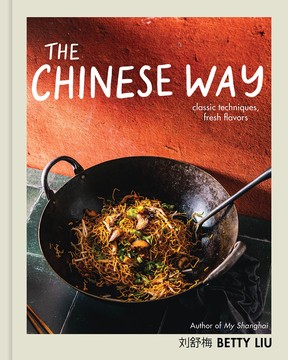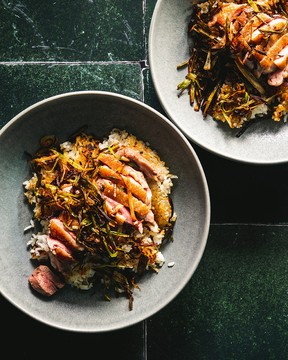Make Betty Liu's pan-seared duck breasts with scallion-crisped rice, miso-sesame chicken with pearl barley and fried farro with lap cheong and cabbage
Get the latest from Laura Brehaut straight to your inbox
Published Jan 10, 2025 • Last updated 0 minutes ago • 10 minute read

Our cookbook of the week is The Chinese Way by author, surgery resident and photographer Betty Liu.
Jump to the recipes: pan-seared duck breasts with scallion-crisped rice, miso-sesame chicken with pearl barley, and fried farro with lap cheong and cabbage.
For Betty Liu, learning to cook came down to the techniques. As a university student cooking for herself for the first time 16 years ago, her early attempts at the home-style Chinese food she grew up with were, admittedly, failures. “I would call my parents, and they were like, ‘Look, you’re approaching this from the wrong way. Don’t think about the end dish. Think about: If you know how to stir-fry, you’ll know what to do with the tomato and egg.'”
Advertisement 2
THIS CONTENT IS RESERVED FOR SUBSCRIBERS
Enjoy the latest local, national and international news.
- Exclusive articles by Conrad Black, Barbara Kay and others. Plus, special edition NP Platformed and First Reading newsletters and virtual events.
- Unlimited online access to National Post and 15 news sites with one account.
- National Post ePaper, an electronic replica of the print edition to view on any device, share and comment on.
- Daily puzzles including the New York Times Crossword.
- Support local journalism.
SUBSCRIBE FOR MORE ARTICLES
Enjoy the latest local, national and international news.
- Exclusive articles by Conrad Black, Barbara Kay and others. Plus, special edition NP Platformed and First Reading newsletters and virtual events.
- Unlimited online access to National Post and 15 news sites with one account.
- National Post ePaper, an electronic replica of the print edition to view on any device, share and comment on.
- Daily puzzles including the New York Times Crossword.
- Support local journalism.
REGISTER / SIGN IN TO UNLOCK MORE ARTICLES
Create an account or sign in to continue with your reading experience.
- Access articles from across Canada with one account.
- Share your thoughts and join the conversation in the comments.
- Enjoy additional articles per month.
- Get email updates from your favourite authors.
THIS ARTICLE IS FREE TO READ REGISTER TO UNLOCK.
Create an account or sign in to continue with your reading experience.
- Access articles from across Canada with one account
- Share your thoughts and join the conversation in the comments
- Enjoy additional articles per month
- Get email updates from your favourite authors
Article content
This realization helped shape the structure of Liu’s second book, The Chinese Way (Voracious, 2024). The Boston-based cookbook author, surgery resident and photographer devotes each of the eight chapters to a foundational Chinese cooking technique: steam, fry, boil, braise, sauce, infuse, pickle and wrap. She illustrates the methods with a few traditional recipes followed by nontraditional ones, all in the hopes of breaking down barriers to Chinese cooking.
In her cookbook debut, My Shanghai (Harper Design, 2021), Liu spotlighted the seasonality of Shanghainese cuisine. With The Chinese Way, she extends the same “see one, do one, teach one” method she follows in her surgical training. The idea is that when you’re learning something new, you observe first and then do it. Through the act of doing, you gain those skills for yourself. The ultimate sign of mastery is when you can teach them to someone else, says Liu.
“I wanted this book to be a resource, which is why I organized it by technique instead of the more conventional way by ingredient or type of ingredient or by lunch, dinner, etc. If someone wants to learn about, say, steam, they can flip through a chapter, and then by cooking through the chapter, I’m hoping I can guide them through the ‘see one, do one, teach one’ way.”
Advertisement 3
Article content
Liu begins each chapter by describing the technique. The first two to three recipes illustrate time-honoured applications of the method. The rest feature unconventional ingredients, which Liu hopes will open up a world of possibilities. She wrote The Chinese Way to teach — to show readers that they can cook Chinese with what they have.
Consider Liu’s sausage and cauliflower chow mein, which she included in the book because it features two ingredients not commonly associated with Chinese cuisine: cauliflower and sausage. “It’s a pantry dish. It doesn’t just have to have carrots, mushrooms, bamboo, beef or chicken. You can use whatever you have in your refrigerator.”
As someone who often works 60 to 80 hours a week, Liu cooks by starting with the ingredients — not a recipe. If she has a head of broccoli in the fridge, Liu thinks of the possible cooking techniques: stir-frying, steaming or blanching. “When I go to the grocery store, I just load it up with food I like to cook with. I’m not planning the end dishes for every day of the week. I’m mostly going on the fly. So, (The Chinese Way) reflects the way I cook — maybe a little chaotically,” says Liu, laughing.
By signing up you consent to receive the above newsletter from Postmedia Network Inc.
Article content
Advertisement 4
Article content

With each recipe, Liu wanted to showcase the central technique differently, with various vegetables and proteins. Take steaming, for example. You can add flavour before steaming, such as in Liu’s miso-sesame chicken with pearl barley, where you marinate the meat and then steam it. Her buttery steamed broccolini with fish sauce incorporates flavour while steaming, and her steamed eggplant is flavoured afterwards by pouring over a tamarind vinaigrette.
One of the things Liu learned from talking to readers of My Shanghai was that people unfamiliar with Chinese food can feel intimidated to cook it without the “right” equipment and ingredients. They sent messages asking what type of wok they should have and what brand of soy sauce to buy.
Some cooks thought they needed to have everything perfect before they attempted a recipe. Liu could relate. “I was there at one point. I would call my parents and ask them on FaceTime which soy sauce I should get. One thing I realized once I became a more instinctive cook is that you can cook Chinese without all your ducks in a row. Part of the ethos of Chinese cooking is using what you have in your kitchen.”
Advertisement 5
Article content
The most meaningful moments on Liu’s book tour this past fall were talking to people about how they cook. One reader from New England told Liu that her use of maple syrup in Chinese cooking gave them confidence in their own ingredient choices. “They thought that using maple syrup in a sauce invalidated the fact that they’re making a stir-fry. I think that notion is ridiculous, and it’s just the epitome of gatekeeping.”
Liu came up with the title of The Chinese Way to succinctly convey that the book is about approach. She isn’t “very spiritual or religious” but notes that “the way” is a core principle of Taoism. The Chinese Way resonated with her because it communicates the ethos behind Chinese cooking instead of dictating the outcome: “The journey, not the end result.”
Though awareness is increasing, many people in the West still expect Chinese food to look and taste a certain way, says Liu. “Food isn’t stagnant. It’s always evolving. It’s a product of context — where you are in time, where you are in space, where you are mentally. In five years, the way I cook won’t be the same as what I’m cooking right now. And if it did, I would be disappointed in myself because that means nothing really has happened in five years.”
Advertisement 6
Article content
Liu makes Chinese food with maple syrup, miso and Parmigiano-Reggiano, which she admits is probably shocking to some traditionalists. “I actually do expect some pushback from the gatekeepers of Chinese food,” adds Liu. “But I think that truly reflects what many first- and second-generation Chinese Americans and Chinese Canadians are cooking now.”
Recommended from Editorial
-

From pickle everything to rat cakes, expect these fun food and drink trends in 2025
-

The most popular recipes in 2024, from creamed lobster dip to ten cloves garlic lemon chicken
PAN-SEARED DUCK BREASTS WITH SCALLION-CRISPED RICE

Serves: 2
2 skin-on duck breasts (6 to 8 oz/170 to 225 g each)
Kosher salt
6 scallions, trimmed, chopped into 1 1/2-inch segments, and slivered into thin shreds
2 cups (340 g) leftover cooked rice (from about 1 cup raw rice)
Step 1
Score the skin on the duck breasts with a sharp knife in a shallow, tight crosshatch pattern.
Step 2
Season with salt all over. Let sit for 15 minutes at room temperature.
Step 3
Lay the duck breasts skin side down in a cold large skillet and set over low heat. Press down with your spatula or a weight so all the skin comes in contact with the pan. You will begin to hear a hissing sound.
Advertisement 7
Article content
Step 4
Adjust the heat level — low to medium-low — until there is a low, continuous bubbling sound. When the fat has started to render, about 5 minutes into the process, scatter in the scallion shreds. Cook for about 15 minutes total. The edges of the duck breast will have started to change colour, and plenty of fat should have rendered out.
Step 5
Increase the heat to medium for 1 minute, and flip the duck breasts. Cook for another 3 minutes, skin side up. The skin should be golden brown and crispy. The interior of the duck breast should be 130F to 140F (54C to 60C) for medium-rare to medium-well doneness.
Step 6
Leaving the scallions in the pan, transfer the duck breasts to a plate and let rest for at least 7 to 8 minutes before slicing.
Step 7
While the duck rests, continue cooking the scallion shreds on low heat until they are browned and crispy, about 5 minutes more. With a slotted spoon, remove them from the pan and set aside.
Step 8
Pour off all but 3 tablespoons of the fat; save it for another dish. Add the rice to the pan and use a spatula to spread it in an even layer, pressing down to compact slightly and ensure full contact with the pan.
Advertisement 8
Article content
Step 9
Increase the heat to medium and cook until the bottom of the rice is lightly golden and crispy, about 5 minutes.
Step 10
Use the spatula to turn the rice cake. (It’s OK if it breaks.) Crisp the other side for about 2 minutes.
Step 11
Divide the rice among two serving plates. Slice the duck breast and fan the slices out on top of the rice. Pile the reserved scallion shreds on top and serve.
MISO-SESAME CHICKEN WITH PEARL BARLEY

Serves: 4
Miso-sesame marinade:
1/2 cup water
3 tbsp toasted sesame oil
2 tbsp red miso
2 tbsp Shaoxing wine
1 tbsp light soy sauce
1 tbsp honey
2 lb (910 g) boneless, skinless chicken thighs, cut into 1 1/2-inch chunks
1/2 cup (107 g) medium pearl barley
1 tbsp cornstarch mixed with 1 tbsp water
Soy-scallion sauce:
1 tbsp neutral oil, such as canola or grapeseed
3 scallions, trimmed and minced
1/4 cup (60 g) water
1 tbsp light soy sauce
1 tsp sugar
Step 1
Make the marinade: Mix all the ingredients in a small bowl. Pour into a resealable plastic bag or container, add the chicken and stir. Let sit in the fridge for at least 2 hours or overnight.
Step 2
Bring a medium saucepan of water to a boil over high heat. Add the barley and cook until al dente, 15 to 20 minutes. Drain and set aside until you’re ready to cook the chicken.
Advertisement 9
Article content
Step 3
The chicken should have absorbed much of the marinade — if not, stir a few more times. Fold in the cornstarch slurry.
Step 4
Set a bamboo steamer over 2 inches of water in a wok or add 2 inches of water to a metal steamer and place the steamer basket in the pot. Bring to a boil, then reduce the heat to a brisk simmer.
Step 5
Spread the cooked barley in a large, shallow, heatproof bowl that will fit into your steamer. Layer the chicken over the pearl barley. Place the bowl in the steamer, cover and steam over medium-high heat until the chicken is cooked through — a thermometer should read 165F (74C). (The wider your bowl, the less time this will take.) Check at 10 minutes; if the chicken is not yet done, stir gently and cook for 5 to 10 minutes more.
Step 6
Remove from the heat, and let sit, still tightly covered, for 5 minutes.
Step 7
Meanwhile, make the soy-scallion sauce: Heat the neutral oil in a small saucepan over medium-low heat. Add the scallions and sauté for about 1 minute, until fragrant. Add the water, soy sauce and sugar, let simmer for another minute until slightly thickened, then remove from the heat.
Advertisement 10
Article content
Step 8
Pour the soy-scallion sauce over the chicken and serve in bowls.
Substitute: You can make this dish with bone-in chicken drumsticks or thighs, which are even more succulent. Use a cleaver or heavy knife to chop them into pieces (or ask your butcher to), and add 4 minutes to the cooking time.
FRIED FARRO WITH LAP CHEONG AND CABBAGE

Serves: 4
1 cup (7 oz/200 g) uncooked pearled farro
3 cups (720 g) water
1/2 tsp kosher salt, plus more to taste
1 tsp extra-virgin olive oil
3 tbsp neutral oil, such as canola or grapeseed
4 links lap cheong (4 oz/115 g total), diced
1 shallot, thinly sliced
3 garlic cloves, roughly chopped
1 tsp smoked paprika
1/2 tsp ground turmeric
1/2 tsp freshly ground black pepper, plus more to taste
8 oz (225 g) napa cabbage, cut into 1/2-inch slivers
1 tsp light soy sauce
1/2 tsp sugar
Grated zest and juice of 1 lemon
4 fried eggs (optional)
Step 1
Rinse the farro and cover with the water in a medium saucepan. Season with the salt and olive oil. Bring to a boil, then reduce the heat to low to maintain a simmer. Cover and cook until the farro is al dente, approximately 25 minutes. Drain and set aside.
Advertisement 11
Article content
Step 2
Heat a wok over medium-high heat until a drop of water evaporates on contact. Add the neutral oil and swirl to coat the wok. Add the lap cheong, stirring often until it begins to brown and the fat has rendered, about 2 minutes.
Step 3
Add the shallot and stir-fry, tossing often, until brown, about 3 minutes. Add the garlic and stir-fry briefly until fragrant. Stir in the paprika, turmeric and black pepper and allow the spices to bloom in the oil.
Step 4
Fold in the cabbage and cook until just wilted, about 5 minutes, and then let it sit undisturbed for 3 to 5 minutes, until it begins to char. Stir well, then let sit undisturbed for another 90 seconds.
Step 5
Add the farro and stir-fry to combine, then add the soy sauce and sugar and stir-fry. Season with salt and pepper to taste.
Step 6
Remove from the heat, stir in the lemon zest, and season with lemon juice. Serve immediately, topped with a fried egg (if using).
Note: You can use 2 1/2 cups cooked farro and skip the first step.
Substitute: If you can’t find lap cheong, you can substitute any cured meat for that salty, umami flavour, such as Spanish chorizo.
Recipes and images excerpted from The Chinese Way by Betty Liu. Copyright ©2024 by Betty Liu. Photographs by Betty Liu. Used with permission of Voracious, an imprint of Little, Brown and Company. New York, NY. All rights reserved.
Our website is the place for the latest breaking news, exclusive scoops, longreads and provocative commentary. Please bookmark nationalpost.com and sign up for our cookbook and recipe newsletter, Cook This, here.
Article content
Get the latest from Laura Brehaut straight to your inbox
.png)
 3 hours ago
9
3 hours ago
9




































 Bengali (BD) ·
Bengali (BD) ·  English (US) ·
English (US) ·